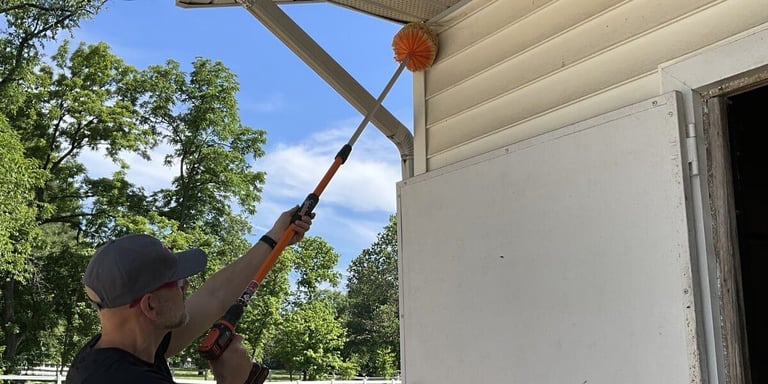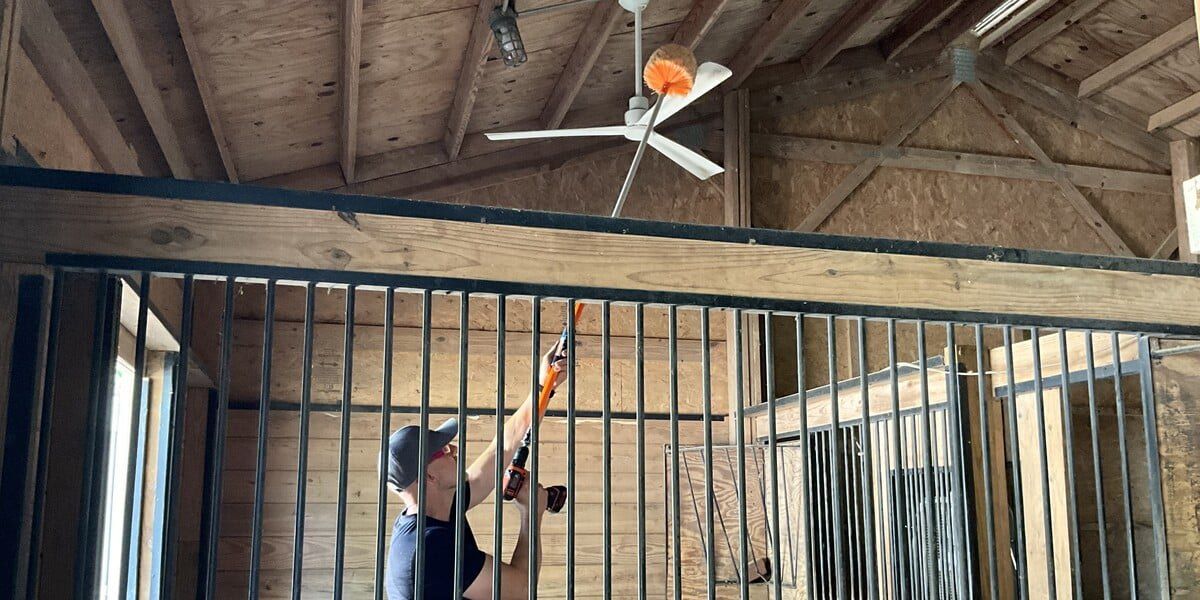Subscribe now and get our latest blog and video content delivered straight to your inbox.
SpinAway vs. Cobweb Duster: Which is Best to Remove Spider Webs?

Sep 18, 2023

If you’re a pest control professional, you know that de-webbing — the removal of spider webs from a client’s home — is an important part of the job. You may not put much thought into your cobweb duster, though; in fact, it’s possible that you’ve been using the same company-assigned spider web removal brush for years at a time without even realizing that there are different options available.
One such option is SpinAway, a drill-powered extendable brush that HY-C manufactures. SpinAway is good for all kinds of cleaning jobs, and, as we’ve used it and tested it ourselves, we’ve been particularly impressed with its de-webbing capabilities.
But is it the right tool to add to your pest control toolkit?
In this article, we’ll compare SpinAway to the classic, tried-and-true cobweb duster. After you’re done reading, you’ll know the pros and cons of each kind of de-webbing tool, and you’ll be ready to decide whether you want to keep using your traditional brush or if you’re the right kind of person to give SpinAway a try.
SpinAway: 3 Cobweb Removal Pros
Click and drag the image above to rotate it. Double-click to zoom in.
1. Automated Spinning Brush Head
When removing spider webs from a home, pest control professionals are taught to rotate their brush to sweep cobwebs away effectively and efficiently. With traditional brushes, this is a labor-intensive process. But SpinAway is designed to do the job for you.
SpinAway is made with a drill bit built into the end of its handle. All you have to do is attach the bit to a drill, extend the brush head to the appropriate length, and pull the drill’s trigger. The brush head will spin, utilizing centripetal force to sweep cobwebs from gutters, downspouts, and eaves — no arm or wrist twisting required.
2. Pain-Free De-Webbing
Pest control professionals know that as the day wears on, cobweb dusting can take its toll. Pushing and spinning that brush head back and forth across multiple houses for hours at a time is demanding on back and arm muscles.
SpinAway takes the torque out of your muscles and transfers it into the drill. All an operator has to do is hold the brush head in place and maintain proper posture. The rotation from the drill provides the cleaning force, giving your muscles a reprieve.
3. Faster Cobweb Removal
Cleaning spider webs from a house with a cobweb duster is a lot like mopping a floor: you have to push back and forth, ensuring you sweep up every web from every surface. De-webbing this way necessitates some overlap in the sections you’re scrubbing, which can add to the time it takes to get the job done.
With SpinAway, there’s no need for the “mop method” of de-webbing; just touch the brush head to the surface of the house, pull the drill’s trigger, and walk a straight line from one corner of the house to the next. The rotating head will catch the webs from all the cracks and crevices of the home with little to no need to go over the same surface twice.
SpinAway: 3 Cobweb Removal Cons

1. Requires a Cordless Drill
One of SpinAway’s biggest strengths as a de-webbing tool may also be its biggest weakness to some: to use it to its potential, you’ll need a battery-powered drill. This can mean additional upfront costs ($40 to $100 or more for a drill and $30 to $50 or more for batteries), and if the batteries die or the drill breaks, it goes back to being just like any old cobweb duster.
The saving grace here is that most pest control professionals already have a cordless drill for removing downspouts, drilling holes to add and bait, etc. Even if you do already carry a drill with you on the job, be sure to note that SpinAway is very demanding on the life of your batteries, and it may be necessary to purchase a few extras. Also, keeping all those batteries fully charged will be its own battle.
2. Shorter than Traditional Cobweb Dusters
Classic extendable de-webbing tools clock in at anywhere from 12 to 20 feet long — plenty long enough to remove cobwebs from the exterior of just about any home. SpinAway, on the other hand, extends only to 5 feet in length, falling well short of even average-length cobweb dusters.
If you’re a pest control professional who works mostly on single-story buildings, SpinAway’s length shouldn’t be a problem. In terms of total reach (i.e., the length of the tool itself plus the amount of distance an average user can reach), SpinAway is good for about 10 feet. If you’re de-webbing two-story houses or other taller structures, though, the extra length of a traditional cobweb duster may be better for you.
3. Price
SpinAway retails for about $60. Other comparable cobweb dusters typically cost somewhere from $30 to $45, and that’s without even factoring in the cost for a drill and batteries, which can easily add at least another $50.
Is SpinAway the Right Web Removal Tool for You?
Before now, you may not have given much thought to your cobweb duster. Now that you’re aware of SpinAway and its de-webbing capabilities, you may be wondering whether or not it’s the right tool for you.
If you’re looking to keep a low budget, you don’t already have a cordless drill, or you need to de-web two-story houses on a frequent basis, SpinAway may not be the right cobweb duster for you.
But if you have some money to spare, you already have a drill and some batteries, or especially if other de-webbing tools have been causing you pain in your back, hips, or arms, you may want to give SpinAway a try. It’s light, it’s quick, and its rotating brush head does a lot of the heavy lifting for you, keeping you fresh for the next job.

